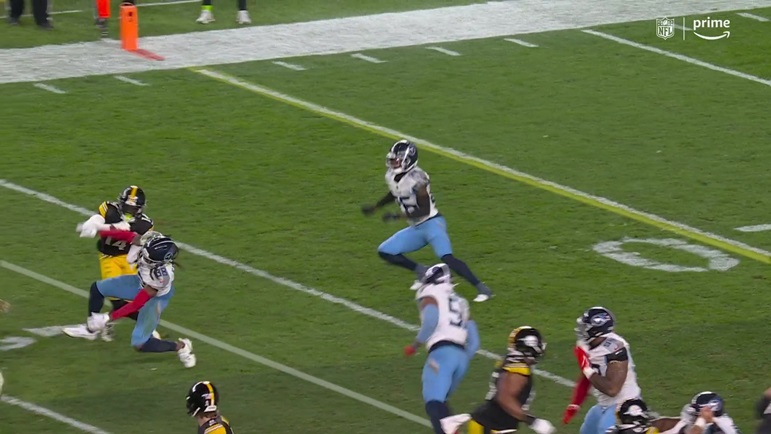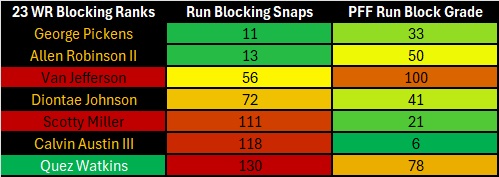The Pittsburgh Steelers WR room saw many changes this offseason. They moved on from former players, brought in several free agents, and selected one in the 2024 draft. There is also the big question if they are done adding, considering the current lack of a clear answer at WR2.
The goal of this article is to examine the current group in run blocking in the NFL last season and see what that could mean for the position in 2024.
Here are run blocking snaps (minimum of 100) and PFF run block grades:
Very interesting. Starting with the clear No. 1 receiver for 2024, George Pickens had the best balance of both data points. He led the group with 351 run block snaps, which also ranked 11th out of the 130 qualifiers, playing in all 17 games last season. Knock on wood that reoccurs, considering the room being top-heavy, knowing the team will lean on him this year, barring any additional moves.
Pickens had a 58.9 run block grade (33rd), which doesn’t sound overly impressive, but was one of only five wide receivers with an above-the-mean grade and 350-plus run block snaps. That list is: Colts Alec Pierce (441 run block snaps, 66.1 run block grade), Bears DJ Moore (405, 64.1), Lions Amon-Ra St. Brown (397, 65.0), Rams Puka Nacua (364, 76.1), and Pickens. Hopefully that trends even more positively for the latter heading into 2024.
We did see moments where Pickens took plays off, which reminds me to share an aspect of how PFF grades wide receivers as run blockers:
“If a receiver is far enough from a run play that their block has no effect on the play, they are not given a PFF run-blocking grade. For example, if an offense runs power, a concept designed to hit between the guard and tackle, and goes for three yards, then whatever the receiver did as a blocker didn’t matter, and they don’t receive a grade.”
This is a very important context, and whether or not we agree with this aspect of their grading, it sheds light on the results.
The only other Steelers WR we’re focused on who landed above-average in both was former Steeler Allen Robinson II. He also appeared in all 17 games last season, with 339 run block snaps, which ranked 13th in the league in 2023 and slightly above the mean 55.6 run block grade (T-50th).
Pittsburgh was a heavy 11-personnel team the last several seasons (one running back, one tight end, three wide receivers), with Robinson playing the primary slot role in 2023. The third Steelers WR role will seemingly be diminished under OC Arthur Smith, who likes to primarily run heavier personnel with less wide receivers on the field.
That doesn’t negate the concern for many, making quality over quantity even more important, in my opinion. The main loss that seemingly wasn’t addressed with an equivalent player was Diontae Johnson. We see he was also above-average with a 57.6 run block grade that tied for 41st. The unfortunate side was having to deal with an injury, playing in just 13 games, thus having a below-average 198 run block snaps (T-72nd).
Among new additions to the Steelers WR room, the player with the most comparable reps to Johnson was Van Jefferson, actually exceeding him in opportunity while appearing in all 17 games in Atlanta last season. That connection and above-average reps under Smith could help Jefferson’s cause in a Steelers uniform, 225 run-blocking snaps to be exact, which ranked 56th. The quality, at least in PFF’s eyes, left much to be desired though with a 46.5 run block grade that tied for 100th.
Considering how important run blocking will be for the Steelers WR2 role that’s up for grabs, that doesn’t exactly give warm and fuzzy feelings. Many have speculated, and when looking at Smith’s former teams, there has been a committee approach behind the top dog in his wide receiver rooms.
This was true for another former Falcon, Scotty Miller. We can see he was utilized at a lower 133 run block snaps in 17 games (T-111th), and the other big difference from his former teammate in Jefferson was a much stronger 63.7 run block grade that ranked 21st. That is encouraging for a smaller receiver (listed at 5-9” 174), and hopefully can continue that quality over quantity with Smith and the black and gold.
I did a similar study on college wide receivers’ run blocking recently to see how Roman Wilson fared last season. He had 193 run-blocking snaps, which ranked 25th out of the 34 qualifiers at the position, along with a 58.2 run-block grade (20th). It is important to remember the college football season is shorter, with 12 regular season games, so a higher run-blocking rate than someone like Miller, who had a stronger grade against stronger NFL competition.
The last qualifying offseason addition (to date) was Quez Watkins, who last played with the Eagles. He was the only player in our sights that was below the mean in both data points, with 100 run blocking snaps was least among qualifiers, and a 50.7 run block grade that ranked 78th. He only appeared in nine games, missing time due to injury. It’s the least usage context, but the second-worst run-blocking grade of players in our sights is unfortunate.
The biggest surprise I wasn’t expecting going into the article was Calvin Austin III. He didn’t run block often, with 122 reps (118th) in 17 games, but received a 71.7 run-blocking grade that landed impressively near the top at sixth. Some have speculated that he could be primed to take on a larger role in 2024.
If so, run blocking could be a key component for him and the rest of the group to separate themselves positively (or negatively), especially if the team doesn’t make a significant add prior to the start of the season. One thing’s for sure: I can’t wait to see how it pans out.
To close, here is a wrap-up table of the data:










